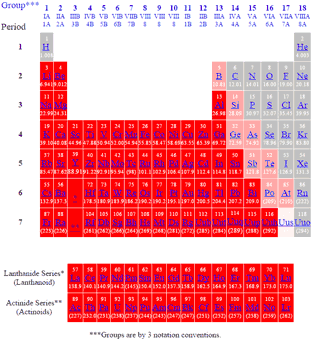
Indium
| Element | Indium |
| Symbol | In |
| Atomic Number | 49 |
| Molar Mass | 114.82 gmol-1 |
| Electron Configuration | [Kr]4d105s25p1 |
| Normal State | solid metal |
| Density @STP | 7.29 g cm-3 |
| Melting Point | 157oC |
| Boiling Point | 2072oC |
| Stable Isotopes | 113In, 115In |
| Atomic Radius | 167 pm |
| Ionic Radius | 72 (3+) pm |
| Electronegativity (Pauling) | 1.78 |
| Ionization Energy (1st) | 558 kJ mol-1 |
| Ionization Energy (2nd) | 1821 kJ mol-1 |
| Ionization Energy (3rd) | 2704 kJ mol-1 |
| Molar Heat Capacity | 26.7 J K-1mol-1 |
| Standard Molar Entropy | 57.8 J K-1mol-1 |
| Enthalpy of Fusion | 3.27 kJ mol-1 |
| Enthalpy of Vapourization | 226.4 kJ mol-1 |
[Back to Periodic table]
- Indium is a silvery-white, highly ductile post-transition metal element
- Indium discovered by Ferdinand Reich and Hieronymous Theodor Richter (1863)
- Indium was first isolated by Hieronymous Theodor Richter (1864)
- Indium is so soft (Mohs hardness 1.2) that like sodium, it can be cut with a knife
- Indium is a member of group 13 on the periodic table and its properties are mostly intermediate between its vertical neighbours gallium and thallium
- Indium has a low melting point, 156.60 °C higher than gallium, but lower than thallium and tin
- Indium produces a high-pitched crackling sound when bent like tin and is due to crystal twinning
- Below the critical temperature 3.41 K indium becomes a superconductor
- Indium metal does not react with water, but it is oxidized by stronger oxidizing agents such as halogens to give indium(III) compounds
- Indium does not form a boride, silicide, or carbide
- Indium is produced exclusively as a by-product of processing of ores of other metals, mainly sulfidic zinc ores
- Indium phosphide is used as semiconductors and indium tin oxide as thin films for liquid-crystal displays (LCD)
- First large-scale application for indium was coating bearings in high-performance aircraft engines during World War II
- Indium is used in fusible alloys, solders, and electronics
- Indium(III) oxide and indium tin oxide (ITO) are used as a transparent conductive coating on glass substrates in electroluminescent panels
- Indium wire is used as a vacuum seal and a thermal conductor in cryogenics and ultra-high-vacuum applications
- Indium is an ingredient in the gallium–indium–tin alloy galinstan, which is liquid at room temperature and replaces mercury in some thermometers
- Indium alloys with bismuth, cadmium, lead, and tin have low melting points (between 50 and 100 °C) are used in fire sprinkler systems and heat regulators
- Indium is one of many substitutes for mercury in alkaline batteries
- Indium is not thought to be an essential element for any living organism


Telephone: +44 (0)1252 405186
Email: tsc@gordonengland.co.uk
Site Links
Introducing
Nature of Thermal Spray Coatings
Surface Engineering in a Nutshell
Surface Engineering Forum
Thermal Spray Gun Repair Service
Plasma Consumable Parts
Thermal Spray Powder Supplies
Applications:
Thermal Spray Coatings on Carbon and Glass Fibre Reinforced Polymers
HVOF Coating of Paper Making Roll
Abradable Coatings
Photomicrographs
Thermal Spray Processes:
Combustion Wire Thermal Spray Process
Combustion Powder Thermal Spray Process
Arc Wire Thermal Spray Process
Plasma Thermal Spray Process
HVOF Thermal Spray Process
HVAF Thermal Spray Process
Detonation Thermal Spray Process
Plasma Flame Theory
Cold Spray Coating Process
Wear and Use of Thermal Spray Coatings
Corrosion and Use of Thermal Spray Coatings
Glossary of Thermal Spray and Surface Engineering Terms
Image Directory for Thermal Spray Coatings
Plasma Gas Flow Information
Plasma Gas Flow Correction Calculator
Contact Form
Links to other interesting sites related to thermal spray and surface engineering
Reciprocal Links
Periodic Table of the Elements
SI Units
Calculators for Conversion between Units of Measurement
Hardness Testing
Surface Engineering Message Board Archive
Surface Engineering Message Board Archive Index
Photography Gallery2
Photography Gallery3
© Copyright Gordon England




